
Good credit comes with a myriad of benefits: lower interest rates and insurance premiums, greater savings and spending perks. The latter usually comes in the form of a high-end credit card, an elite-status account that provides airline miles, concierge services and more. These cards are reserved for consumers with excellent credit. Many of them also have No Preset Spending Limit (NPSL). After a long journey, owning a NPSL feels like an accomplishment, but how will it affect your credit score?
Factors include:
Credit Utilization
Utilization accounts for 30 percent of your credit score. Measuring the amount owed vs. your total credit limit allows lenders to gauge your dependence on borrowed cash and, consequently, your risk level. In the case of NPSL accounts, the math is a little fuzzy. Many lenders fail to report a limit at all, while others choose to report a high balance. For example, suppose you charged $4,000 in a single month on your NPSL card. The lender may report this amount as a high balance or credit limit, weighing future balances against the highest balance. As a result, charging $1,000 could appear as a 25 percent utilization on your NPSL account.
In either case, failure to report a credit limit or reporting a high balance can drastically impact your credit utilization ratio, causing damage to your score. Ask your lender how they report credit limits before signing up for a NPSL card.
Open or Revolving Account
New accounts are essential for maintaining a dynamic credit score, and it’s important to understand how a NPSL card achieves this goal. Depending on the lender, your account is either reported as open or revolving:
- Open: Listed as a charge card with a balance that must be paid at the end of the month.
- Revolving: Listed as a credit card that may carry a balance month-to-month with no payoff date.
Open accounts are not factored into the FICO 8 model of credit utilization and will not affect your credit score. Ask your lender how they report NPSL accounts.
Liquid Savings
A NPSL card equals unlimited spending, right? Wrong. In fact, many NPSL cards require the balance to be paid in full each month. For example, the American Express Platinum card offers generous membership rewards and no spending limit. That said, cardholders are required to maintain a zero balance at the end of each billing cycle for the majority of purchases. This policy diminishes liquid savings by requiring immediate payment of the balance. On the other hand, it promotes healthy credit by preventing users from carrying high balances and accruing interest. Responsible spending is imperative. Avoid NPSL cards if you have trouble controlling your spending habits. Depleted savings is a catalyst for credit damage.
Annual Fees
Elite credit is full of rewards, but they come at a price. For example, the American Express Platinum card requires an annual fee of $450. In exchange, cardholders are able to accrue frequent flyer miles, enjoy access to airport lounges and travel credits, shop using their points and take advantage of exclusive deals. This card is a wonderful aid for a frequent traveler, but a homebound user would not enjoy the full benefits accompanied by the annual fee. Review the terms and conditions of a NPSL card before applying to determine if the perks are worth the upfront cost.
The bottom line: NPSL accounts are worthwhile for many, but don’t apply based on status alone. Consider the credit implications before taking the next step. Excellent credit requires careful management.
Questions about credit repair?
Chat with an expert: 1-800-255-0263






